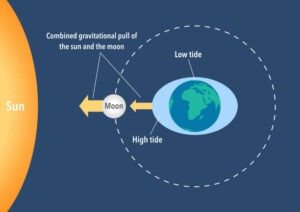This summer, Earth is spinning faster than usual, and while it might sound like science fiction, it’s a very real phenomenon that experts are watching closely. On July 10, 2025, Earth experienced its shortest day of the year so far, ending 1.36 milliseconds earlier than the usual 24 hours. Days in late July and early August are expected to be similarly short.
That tiny difference might seem like it doesn’t matter much, but in the world of high-precision timekeeping, it’s a big deal. The way we keep track of time depends on extreme accuracy — down to fractions of a second. And when Earth’s spin doesn’t quite match up with the atomic clocks that guide our world, we run into a surprisingly tricky problem.
How Do We Measure a Day — And Why It’s Not Always 24 Hours

We often think of a day as being exactly 24 hours long — that’s 86,400 seconds. But in reality, the Earth doesn’t always take the same amount of time to complete one full rotation on its axis. This difference is usually just a few milliseconds, but over time, it can affect critical systems on Earth.
Several factors cause Earth’s spin to vary. These include the gravitational pull of the moon, changes in the atmosphere depending on the season, and even movement in Earth’s liquid core. So while a day might seem the same to us, it’s not always perfectly consistent — and that inconsistency matters.
Atomic Clocks: The Guardians of Global Timekeeping

To handle these tiny changes, we use atomic clocks, which were first introduced in 1955. These clocks are incredibly precise, measuring time based on the vibrations of atoms — typically cesium or rubidium — inside a vacuum chamber.
Atomic clocks define UTC (Coordinated Universal Time), the global standard for time that all our phones, computers, and even satellites rely on. Around 450 atomic clocks around the world work together to keep UTC as accurate as possible.
However, astronomers also track Earth’s actual rotation, often using satellites that compare Earth’s position to fixed stars. By comparing Earth’s real spin with atomic time, we can spot even the smallest difference.
A Glimpse Into the Past: The Leap Second
In 1972, timekeepers introduced the leap second — a single second added to UTC to keep it in sync with Earth’s slower spin. It works similarly to a leap year, which adds an extra day every four years to align our calendars with Earth’s orbit around the sun.
Since then, 27 leap seconds have been added — mostly in the 1970s and 1980s when Earth was spinning more slowly. The last one was in 2016. But here’s where things get interesting: Earth’s spin has been speeding up. That means, instead of adding time, we might soon need to remove a second. This would be known as a negative leap second — and it has never happened before.
The Possibility of a Negative Leap Second
A negative leap second is just like it sounds: one second would be taken away from our official clocks to stay in sync with Earth’s faster rotation. According to Duncan Agnew, a geophysics expert at the University of California, San Diego, there’s about a 40% chance that we’ll need a negative leap second between now and 2035.
While one second might not seem like a big deal, the real challenge is that we’ve never done this before. And considering that many tech systems still struggle with positive leap seconds, this new adjustment could cause a lot of confusion.
Tech Trouble: Why One Second Can Cause Major Issues
Judah Levine, a physicist at the National Institute of Standards and Technology, explains that even now, many systems handle positive leap seconds incorrectly. Some do it at the wrong time, while others use the wrong number or simply crash.
With so many vital systems relying on accurate time — including GPS, financial transactions, telecommunications, and electric grids — even a small mistake could cause widespread issues. Levine compares it to the Y2K bug, where fears that computers couldn’t handle the switch from 1999 to 2000 nearly caused a global panic.
The idea of removing a second from the world clock makes timekeepers nervous — not because it’s impossible, but because it’s untested and could be very disruptive.
Why Is Earth Spinning Faster in the First Place?
Earth’s spin isn’t constant. In fact, it’s always changing slightly due to a mix of natural causes. One of the biggest factors is the moon’s gravitational pull. When the moon is over the equator, it slightly slows down Earth’s spin. But when it’s at higher or lower positions, it can speed things up.

Seasonal changes also play a role. During summer, for example, certain changes in the jet stream and atmosphere reduce drag on the Earth’s surface, allowing the planet to spin a bit faster. And over the last 50 years, Earth’s liquid core has also been slowing down — causing the solid Earth above it to spin faster as a kind of balance.
According to experts, these factors often stack on top of one another. So when the spin speeds up one day, it’s likely to keep speeding up for the next few days as well. However, these trends aren’t always predictable. Over longer periods, like a year or more, forecasts become much less reliable.
Climate Change’s Surprising Role in Earth’s Spin
While climate change is usually discussed for its harmful impacts, it also has an unexpected connection to this story. As ice melts in Greenland and Antarctica, the water spreads out across the oceans, changing Earth’s mass distribution. This has a slowing effect on the planet’s spin — similar to how a spinning figure skater slows down when they stretch out their arms.

Duncan Agnew’s research, published in Nature, shows that melting ice has delayed the need for a negative leap second. Without global warming, we might have already had to remove a second from our clocks.
NASA data also confirms that meltwater from the ice sheets has contributed to one-third of sea level rise since 1993. The melted ice is not only affecting the spin but also shifting Earth’s rotation axis, as shown by research from Benedikt Soja at the Swiss Federal Institute of Technology.
So, while climate change is dangerous in many ways, it’s unexpectedly giving us a little more time to prepare for a negative leap second.
What the Future Holds for Timekeeping
In 2022, the General Conference on Weights and Measures voted to retire the leap second entirely by 2035. The move was meant to simplify global timekeeping, but with Earth now spinning faster, some experts believe we might have to deal with one last leap second — and it could be negative.
For now, timekeepers are watching closely. The International Earth Rotation and Reference Systems Service (IERS) only makes predictions up to a year in advance, so it’s hard to know exactly what will happen. What is certain is that this issue isn’t going away anytime soon.
Judah Levine sums it up well: “I think the (faster spinning) is still within reasonable boundaries, so it could be natural variability. Maybe in a few years, we could see again a different situation, and long term, we could see the planet slowing down again. That would be my intuition, but you never know.”
What Can We Learn from This?
This story reminds us just how complex and interconnected our planet is. Something as simple as the speed at which Earth spins can have deep impacts on technology, science, and our daily lives.
It also shows us how much we rely on precise systems — like atomic clocks — and how even the smallest change can ripple through industries and nations.
As Earth continues to evolve and respond to natural forces and human impact, timekeepers, scientists, and engineers will need to stay one step ahead. Because when it comes to time, even a single second can make a world of difference.
Stay connected with us for more such Why & How articles!
Read the latest news from India and around the world on Khabari Bandhu — covering business, education, entertainment, religion, cricket, horoscope, and much more.
Understanding Parkinson Disease: Causes, Symptoms, and Treatments
Bryan Johnson Blueprint Exit: From Anti-Ageing CEO to ‘Don’t Die’ Visionary
Ozzy Osbourne’s death: The Prince of Darkness Bids Farewell – A Tribute to His Life and Legacy

